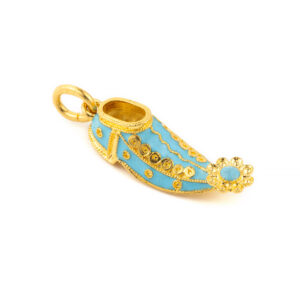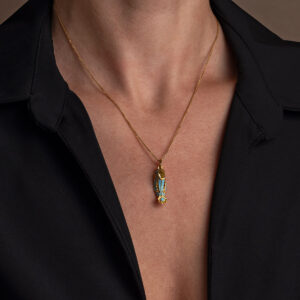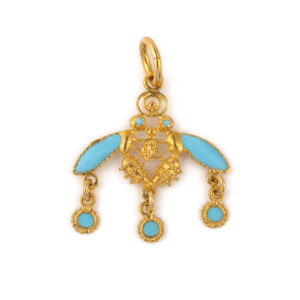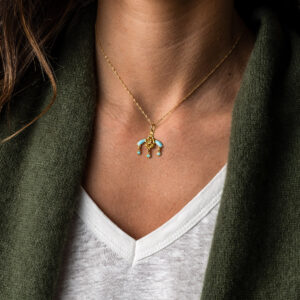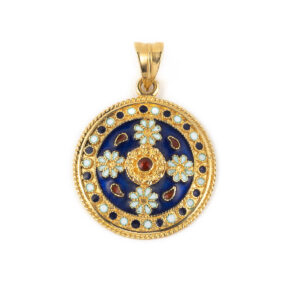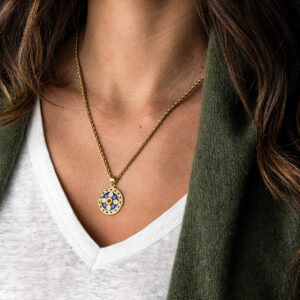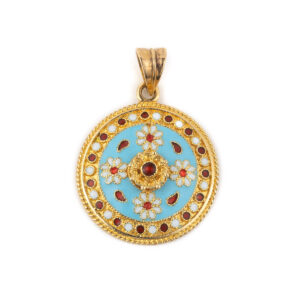14k Gold Meander Filigree Egg Pendant with Turquoise Enamel
612,00€ – 898,00€The pendant is embellished with a fine filigree and turquoise enamel in Faberge style. Also, the pendant is decorated with a Meander design.
Used as a charm or as a pendant.
Pick up a beautiful gift inspired by the majestic art of Fabergé!
Made in 14k yellow gold
Filigree is a delicate kind of jewellery metalwork, made with tiny beads or twisted threads, or both in combination, soldered together or to the surface of an object of the same metal and arranged in artistic motifs. The art of filigree dates back to ancient history. The first of the found jewelry in this technique has been found in Mesopotamia and dates to thousands of years BC. In the ancient world, particularly in Asia Minor, this art grew at the highest level.
Fabergé egg is a jeweled egg created by the House of Fabergé, in St. Petersburg, Imperial Russia. Virtually all were manufactured under the supervision of Peter Carl Fabergé between 1885 and 1917,[citation needed] the most famous being the 50 “Imperial” eggs, 43 of which survive, made for the Russian Tsars Alexander III and Nicholas II as Easter gifts for their wives and mothers. The first Fabergé egg was crafted for Tsar Alexander III, who had decided to give his wife, Empress Maria Feodorovna, an Easter egg in 1885. Peter Carl Fabergé was a Russian jeweller best known for the famous Fabergé eggs made in the style of genuine Easter eggs, using precious metals and gemstones. He’s the founder of the famous jewelry legacy House of Fabergé. (Wikipedia)
Meander or Meandros design, one of the most historic symbols of the Greek World, also called Greek Key and symbolizes long life and eternity.
Μενταγιόν Τσαρούχι – 14Κ Χρυσό
620,00€Have you witnessed the changing of the guards in Syntagma square? This is the most traditional shoe of Greece (tsarouhi). The pendant is decorated with turquoise enamel and rosette motif. The rosette (rose) is a timeless jewel, symbol and amulet. The origin of the term is the Greek word for rose – rodon (ρόδον). Its use began in the Mycenaean era and continues as far as the 2nd millennia BC. The Mycenaean Rosette is a motif that was widespread throughout Mesopotamia, Egypt, Greece and other ancient civilizations. Rosette or Rodax was probably the most popular and favorite decorative element in Mycenaean era, classical antiquity and Byzantine times.
Made in 14k yellow gold.
Used as a charm or as a pendant.
Design inspired by the Greek tradition
A tsarouchi (τσαρούχι) is a type of shoe, which is typically known nowadays as part of the traditional uniform worn by the Evzones of the Greek Presidential Guard. Their origin goes back to the Byzantine times. Originally, various types of similar shoes were worn all over the Balkans, but tsarouchia are mainly associated with the Greeks. They were the most common footwear worn by both urban and rural Greeks, mainly men, but also many women. After the Greek independence in early 19th century, their use was limited to isolated rural areas and nomadic populations. Tsarouciia provide a clear link with the origin of the Evzone uniform in the traditional Greek costume, and with the fact that Evzones were largely enlisted from rural mountainous regions of Greece. Nowadays they are almost exclusively used by the presidential guard and in various traditional festivals and dances along with other traditional Greek garments.(source wikipedia)
Μενταγιόν Μπουζούκι – 14Κ Χρυσό
920,00€Greek Bouzouki Charm with turquoise enamel. The pendant is decorated with rosette motifs.
Made in 14k yellow gold.
Used as a charm or as a pendant.
Design inspired by the Greek tradition
The Greek bouzouki is a plucked musical instrument of the lute family, called the thabouras or tambouras family. The tambouras has existed in ancient Greece as pandoura, and can be found in various sizes and shapes. The bouzouki and the baglamas are the direct descendants. The bouzouki arrived in Greece following the 1919–1922 war in Asia Minor and the subsequent exchange of populations between Greece and Turkey when the ethnic Greeks fled to Greece. At the end of the 1950s, four-course (tetrachordo) bouzoukia started to gain popularity. The four-course bouzouki was made popular by Manolis Chiotis. Manolis Chiotis was a Greek rebetiko and laiko composer, singer, and bouzouki player. He is considered one of the greatest bouzouki soloists of all time. In the summer of 1961, he played for Aristotle Onassis and Maria Callas and Grace Kelly. Callas told Chiotis that she had been translating the lyrics of his songs to Princess Grace all night long and the American actress loved them because “she is a woman in love.” At that moment, Kelly asked Chiotis what the difference between a bouzouki and an electric guitar is. Chiotis’ answer was rather unexpected; “Mrs. Callas, please explain to Princess Grace that the strings of an electric guitar vibrate due to electricity, while the strings of a bouzouki vibrate through the heart.” *
The rosette (rose) is a timeless jewel, symbol and amulet. The origin of the term is the Greek word for rose – rodon (ρόδον). Its use began in the Mycenaean era and continues as far as the 2nd millennia BC. The Mycenaean Rosette is a motif that was widespread throughout Mesopotamia, Egypt, Greece and other ancient civilizations. Rosette or Rodax was probably the most popular and favorite decorative element in Mycenaean era, classical antiquity and Byzantine times.
18K Xρυσό Μενταγιόν Μινωική Μέλισσα
378,00€Αυτό το μενταγιόν είναι σχεδιασμένο από χρυσό 18 καρατίων με τυρκουάζ/μπλε σμάλτο, εμπνευσμένο από το μινωικό μενταγιόν της Μέλισσας. Το μενταγιόν της μέλισσας των Μαλίων ανακαλύφθηκε στον Χρυσόλακκο, του μινωικού παλατιού των Μαλίων στο νησί της Κρήτης, και πιστεύεται ότι χρονολογείται γύρω στο 1800 π.Χ. Το όνομα Χρυσόλακκος σημαίνει “λάκκος του χρυσού” λόγω των πολύτιμων αντικειμένων που συνήθιζαν να βρίσκουν εκεί οι αγρότες. Το μινωικό ανάκτορο βρίσκεται 3 χλμ. ανατολικά της πόλης των Μαλίων και είναι το τρίτο πιο σημαντικό γνωστό μινωικό ανάκτορο μετά την Κνωσό και τη Φαιστό.
Αυτό το μενταγιόν έχει το σχήμα δύο μελισσών ή σφηκών, που αποθηκεύουν μια σταγόνα μέλι σε μια κηρήθρα και είναι ένα από τα πιο διάσημα εκθέματα του Μουσείου Ηρακλείου.
Χειροποίητο ελληνικό κόσμημα.
Η αλυσίδα που φαίνεται στην τρίτη εικόνα είναι η 14Κ στριφτή αλυσίδα μας (δεν περιλαμβάνεται).
18Κ Χρυσό Μπλε Μενταγιόν με Αρχαια Ελληνική Ροζέτα
1.436,00€Αρχαίο Ελληνικό Στρογγυλό Μενταγιόν με φλοράλ μοτίβο (τέσσερα μοτίβα ροζέτα). Το μενταγιόν είναι διακοσμημένο με τυρκουάζ & κόκκινο σμάλτο και κόκκους πολύτιμου μετάλλου. Η πίσω πλευρά του μενταγιόν δεν έχει διακόσμηση.
Σχεδιασμός εμπνευσμένος από την απίστευτη ομορφιά της ιστορικής παράδοσης.
Από χρυσό 18 καρατίων.
Διατίθεται επίσης με τυρκουάζ σμάλτο.
Χειροποίητο ελληνικό κόσμημα.
Η αλυσίδα που απεικονίζεται είναι η 14K χρυσή αλυσίδα rope (δεν περιλαμβάνεται).
Ο ροζέτα (τριαντάφυλλο) είναι ένα διαχρονικό κόσμημα, σύμβολο και φυλαχτό.
Η προέλευση του όρου είναι η ελληνική λέξη για το τριαντάφυλλο – rodon (ρόδον). Η χρήση του ξεκίνησε στη μυκηναϊκή εποχή και συνεχίζεται μέχρι τη 2η χιλιετία π.Χ. Η μυκηναϊκή ρόδα είναι ένα μοτίβο που ήταν ευρέως διαδεδομένο σε όλη τη Μεσοποταμία, την Αίγυπτο, την Ελλάδα και άλλους αρχαίους πολιτισμούς. Είναι εμπνευσμένο από μια χάντρα με μυκηναϊκή ροζέτα, που βρέθηκε στις Μυκήνες και χρονολογείται στο 1400-1300 π.Χ. Η ροζέτα χρησιμοποιήθηκε εκτενώς στα αρχαία ελληνικά μυκηναϊκά κοσμήματα, στην αρχιτεκτονική, στην κεραμική και στα γλυπτά από το 1500 π.Χ. Οι μυκηναϊκοί ρόδακες είχαν συνήθως 6 ή 8 ή 12 φύλλα και δεκαέξι φύλλα κατά τη διάρκεια της Μακεδονικής Δυναστείας. Τέτοιες λεπτομέρειες όπως το σχήμα του ρόδακα και ο αριθμός των φύλλων τείνουν να ποικίλλουν ανάλογα με την εποχή ή τις δοξασίες. Οι ρόδακες χρησιμοποιούνταν για τη διακόσμηση των υφασμάτων, των ζωνών και των στεφάνων των βασιλέων. Ο αριθμός των φύλλων είχε συμβολικό χαρακτήρα κάθε φορά. Τα τέσσερα στοιχεία της φύσης (άνεμος, γη, φωτιά, νερό), τα επτά θαύματα του αρχαίου κόσμου ή οι δώδεκα θεοί των αρχαίων Ελλήνων και η παγκόσμια κυριαρχία και ακτινοβολία των βασιλιάδων της Μακεδονίας. Ήταν σημάδια ομορφιάς, αγνότητας, ευζωίας, λατρείας και εξουσίας. Η ροζέτα ή ρόδαξ ήταν ίσως το πιο δημοφιλές και αγαπημένο διακοσμητικό στοιχείο στη μυκηναϊκή εποχή, την κλασική αρχαιότητα και τους βυζαντινούς χρόνους.
18Κ Χρυσό Τυρκουάζ Μενταγιόν με Αρχαια Ελληνική Ροζέτα
1.368,00€Αρχαίο Ελληνικό Στρογγυλό Μενταγιόν με φλοράλ μοτίβο (τέσσερα μοτίβα ροζέτα). Το μενταγιόν είναι διακοσμημένο με τυρκουάζ & κόκκινο σμάλτο και κόκκους πολύτιμου μετάλλου. Η πίσω πλευρά του μενταγιόν δεν έχει διακόσμηση.
Σχεδιασμός εμπνευσμένος από την απίστευτη ομορφιά της ιστορικής παράδοσης.
Από χρυσό 18 καρατίων.
Διατίθεται επίσης με μπλε σμάλτο.
Χειροποίητο ελληνικό κόσμημα.
Η αλυσίδα που απεικονίζεται είναι η 14K χρυσή αλυσίδα rope (δεν περιλαμβάνεται).
Ο ροζέτα (τριαντάφυλλο) είναι ένα διαχρονικό κόσμημα, σύμβολο και φυλαχτό.
Η προέλευση του όρου είναι η ελληνική λέξη για το τριαντάφυλλο – rodon (ρόδον). Η χρήση του ξεκίνησε στη μυκηναϊκή εποχή και συνεχίζεται μέχρι τη 2η χιλιετία π.Χ. Η μυκηναϊκή ρόδα είναι ένα μοτίβο που ήταν ευρέως διαδεδομένο σε όλη τη Μεσοποταμία, την Αίγυπτο, την Ελλάδα και άλλους αρχαίους πολιτισμούς. Είναι εμπνευσμένο από μια χάντρα με μυκηναϊκή ροζέτα, που βρέθηκε στις Μυκήνες και χρονολογείται στο 1400-1300 π.Χ. Η ροζέτα χρησιμοποιήθηκε εκτενώς στα αρχαία ελληνικά μυκηναϊκά κοσμήματα, στην αρχιτεκτονική, στην κεραμική και στα γλυπτά από το 1500 π.Χ. Οι μυκηναϊκοί ρόδακες είχαν συνήθως 6 ή 8 ή 12 φύλλα και δεκαέξι φύλλα κατά τη διάρκεια της Μακεδονικής Δυναστείας. Τέτοιες λεπτομέρειες όπως το σχήμα του ρόδακα και ο αριθμός των φύλλων τείνουν να ποικίλλουν ανάλογα με την εποχή ή τις δοξασίες. Οι ρόδακες χρησιμοποιούνταν για τη διακόσμηση των υφασμάτων, των ζωνών και των στεφάνων των βασιλέων. Ο αριθμός των φύλλων είχε συμβολικό χαρακτήρα κάθε φορά. Τα τέσσερα στοιχεία της φύσης (άνεμος, γη, φωτιά, νερό), τα επτά θαύματα του αρχαίου κόσμου ή οι δώδεκα θεοί των αρχαίων Ελλήνων και η παγκόσμια κυριαρχία και ακτινοβολία των βασιλιάδων της Μακεδονίας. Ήταν σημάδια ομορφιάς, αγνότητας, ευζωίας, λατρείας και εξουσίας. Η ροζέτα ή ρόδαξ ήταν ίσως το πιο δημοφιλές και αγαπημένο διακοσμητικό στοιχείο στη μυκηναϊκή εποχή, την κλασική αρχαιότητα και τους βυζαντινούς χρόνους.



